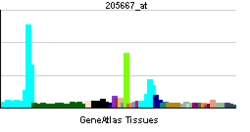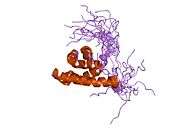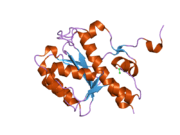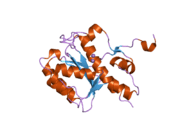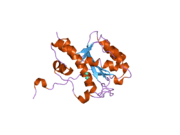Werner syndrome ATP-dependent helicase
| View/Edit Human | View/Edit Mouse |
"Werner syndrome ATP-dependent helicase" also known as DNA helicase, RecQ-like type 3 is an enzyme that in humans is encoded by the WRN gene. WRN is a member of the RecQ Helicase family.[3] Helicase enzymes generally unwind and separate double-stranded DNA. These activities are necessary before DNA can be copied in preparation for cell division (DNA replication). Helicase enzymes are also critical for making a blueprint of a gene for protein production, a process called transcription. Further evidence suggests that Werner protein plays a critical role in repairing DNA. Overall, this protein helps maintain the structure and integrity of a person's DNA.
The WRN gene is located on the short (p) arm of chromosome 8 between positions 12 and 11.2, from base pair 31,010,319 to base pair 31,150,818.
Structure and function
WRN is a member of the RecQ Helicase family. It is the only RecQ Helicase that contains 3' to 5' exonuclease activity. These exonuclease activities include degradation of recessed 3' ends and initiation of DNA degradation from a gap in dsDNA. WRN is important in reparation of double stranded breaks, nonhomologous end joining, and base excision repair.[3] WRN may also be important in telomere maintenance and replication, especially the replication of the G-rich sequences.[4]
WRN is an oligomer that can act as a monomer when unwinding DNA, but as a dimer in solution or a tetramer when complexed with DNA, and has also been observed in tetrameric and hexameric forms. The diffusion of WRN has been measured to 1.62 in nucleoplasm and 0.12 at nucleoli.[5] Orthologs of WRN have been found in a number of other organisms, including Drosohphila, Xenopus, and C. elegans. WRN is important to genome stability, and cells with mutations to WRN are more susceptible to DNA damage and DNA breaks.[6]
The amino terminus of WRN is involved in both helicase and nuclease activities, while the carboxyl-terminus interacts with p53, an important tumor suppressor.[7] WRN may function as an exonuclease in DNA repair, recombination, or replication, as well as resolution of DNA secondary structures. It is involved in branch migration at Holliday junctions, and it interacts with other DNA replication intermediates.[8] mRNA that codes for WRN has been identified in most human tissues.[7]
Post-translational modification
Phosphorylation of WRN at serine/threonine inhibits helicase and exonuclease activities which are important to post-replication DNA repair. De-phosphorylation at these sites enhances the catalytic activities of WRN. Phosphorylation may affect other post-translational modifications, including sumoylation and acetylation.[4]
Methylation of WRN causes the gene to turn off. This suppresses the production of the WRN protein and its functions in DNA repair.[9]
Clinical significance
Werner syndrome is caused by mutations in the WRN gene.[7] More than 20 mutations in the WRN gene are known to cause Werner syndrome. Many of these mutations result in an abnormally shortened Werner protein. Evidence suggests that the altered protein is not transported into the cell nucleus, where it normally interacts with DNA.[10] This shortened protein may also be broken down too quickly, leading to a loss of Werner protein in the cell. Without normal Werner protein in the nucleus, cells cannot perform the tasks of DNA replication, repair, and transcription.[11] Researchers are still determining how these mutations cause the appearance of premature aging seen in Werner syndrome.
WRN deficiencies in cancer
Cells expressing limiting amounts of WRN have elevated mutation frequencies compared with wildtype cells.[12] Increased mutation may give rise to cancer. Patients with Werner Syndrome, with homozygous mutations in the WRN gene, have an increased incidence of cancers, including soft tissue sarcomas, osteosarcoma, thyroid cancer and melanoma.[13]
Mutations in WRN are rare in the general population. The rate of heterozygous loss of-function mutation in WRN is approximately one per million. In a Japanese population the rate is 6 per 1,000, which is higher, but still infrequent.[14]
Mutational defects in the WRN gene are relatively rare in cancer cells compared to the frequency of epigenetic alterations in WRN that reduce WRN expression and could contribute to carcinogenesis. The situation is similar to other DNA repair genes whose expression is reduced in cancers due to mainly epigenetic alterations rather than mutations (see Frequencies of epimutations in DNA repair genes).[15]
The table shows results of analysis of 630 human primary tumors for WRN CpG island hypermethylation.[16] This hypermethylation caused reduced protein expression of WRN, a common event in tumorigenesis.[16]
| Cancer | Frequency of reduction in cancer[16] |
|---|---|
| Colorectal cancer | 37.9% |
| Non-small cell lung cancer | 37.5% |
| Gastric cancer | 25% |
| Prostate cancer | 20% |
| Breast cancer | 17.2% |
| Thyroid cancer | 12.5% |
| Non-Hodgkin lymphoma | 23.7% |
| Acute myeloblastic leukemia | 4.8% |
| Chondrosarcomas | 33.3% |
| Osteosarcomas | 11.1% |
Interactions
Werner syndrome ATP-dependent helicase has been shown to interact with:
References
- ↑ "Human PubMed Reference:".
- ↑ "Mouse PubMed Reference:".
- 1 2 Monnat RJ (October 2010). "Human RECQ helicases: roles in DNA metabolism, mutagenesis and cancer biology". Semin. Cancer Biol. 20 (5): 329–39. doi:10.1016/j.semcancer.2010.10.002. PMC 3040982
 . PMID 20934517.
. PMID 20934517. - 1 2 Ding SL, Shen CY (2008). "Model of human aging: recent findings on Werner's and Hutchinson–Gilford progeria syndromes". Clin Interv Aging. 3 (3): 431–44. doi:10.2147/CIA.S1957. PMC 2682376
 . PMID 18982914.
. PMID 18982914. - ↑ Kristian Moss Bendtsen, Martin Borch Jensen, Alfred May, Lene JuelRasmussen, Ala Trusina, Vilhelm A. Bohr & Mogens H. Jensen (2014). "Dynamics of the DNA repair proteins WRN and BLM in the nucleoplasm and nucleoli". European Biophysics Journal. 43: 509–16. doi:10.1007/s00249-014-0981-x. PMID 25119658.
- ↑ Rossi ML, Ghosh AK, Bohr VA (2010). "Roles of Werner syndrome protein in protection of genome integrity". DNA Repair (Amst.). 9 (3): 331–44. doi:10.1016/j.dnarep.2009.12.011. PMC 2827637
 . PMID 20075015.
. PMID 20075015. - 1 2 3 Oshima J (2000). "The Werner syndrome protein: an update". BioEssays. 22 (10): 894–901. doi:10.1002/1521-1878(200010)22:10<894::AID-BIES4>3.0.CO;2-B. PMID 10984715.
- ↑ Pichierri P, Ammazzalorso F, Bignami M, Franchitto A (2011). "The Werner syndrome protein: linking the replication checkpoint response to genome stability". Aging (Albany NY). 3 (3): 311–8. PMC 3091524
 . PMID 21389352.
. PMID 21389352. - ↑ "WRN". US National Library of Medicine. Retrieved 18 March 2014.
- ↑ Huang S, Lee L, Hanson NB, Lenaerts C, Hoehn H, Poot M, Rubin CD, Chen DF, Yang CC, Juch H, Dorn T, Spiegel R, Oral EA, Abid M, Battisti C, Lucci-Cordisco E, Neri G, Steed EH, Kidd A, Isley W, Showalter D, Vittone JL, Konstantinow A, Ring J, Meyer P, Wenger SL, von Herbay A, Wollina U, Schuelke M, Huizenga CR, Leistritz DF, Martin GM, Mian IS, Oshima J (2006). "The spectrum of WRN mutations in Werner syndrome patients". Hum. Mutat. 27 (6): 558–67. doi:10.1002/humu.20337. PMC 1868417
 . PMID 16673358.
. PMID 16673358. - ↑ Lebel M (2001). "Werner syndrome: genetic and molecular basis of a premature aging disorder". Cell. Mol. Life Sci. 58 (7): 857–67. doi:10.1007/s00018-001-8398-y. PMID 11497235.
- ↑ Kamath-Loeb AS, Shen JC, Schmitt MW, Loeb LA (2012). "The Werner syndrome exonuclease facilitates DNA degradation and high fidelity DNA polymerization by human DNA polymerase δ". J. Biol. Chem. 287 (15): 12480–90. doi:10.1074/jbc.M111.332577. PMC 3320997
 . PMID 22351772.
. PMID 22351772. - ↑ Goto M, Miller RW, Ishikawa Y, Sugano H (1996). "Excess of rare cancers in Werner syndrome (adult progeria)". Cancer Epidemiol. Biomarkers Prev. 5 (4): 239–46. PMID 8722214.
- ↑ Chun SG, Shaeffer DS, Bryant-Greenwood PK (2011). "The Werner's Syndrome RecQ helicase/exonuclease at the nexus of cancer and aging". Hawaii Med J. 70 (3): 52–5. PMC 3071901
 . PMID 21365542.
. PMID 21365542. - ↑ Carol Bernstein and Harris Bernstein (2015). Epigenetic Reduction of DNA Repair in Progression to Cancer, Advances in DNA Repair, Prof. Clark Chen (Ed.), ISBN 978-953-51-2209-8, InTech, Available from: http://www.intechopen.com/books/advances-in-dna-repair/epigenetic-reduction-of-dna-repair-in-progression-to-cancer
- 1 2 3 Agrelo R, Cheng WH, Setien F, Ropero S, Espada J, Fraga MF, Herranz M, Paz MF, Sanchez-Cespedes M, Artiga MJ, Guerrero D, Castells A, von Kobbe C, Bohr VA, Esteller M (2006). "Epigenetic inactivation of the premature aging Werner syndrome gene in human cancer". Proc. Natl. Acad. Sci. U.S.A. 103 (23): 8822–7. doi:10.1073/pnas.0600645103. PMC 1466544
 . PMID 16723399.
. PMID 16723399. - ↑ von Kobbe C, Karmakar P, Dawut L, Opresko P, Zeng X, Brosh RM, Hickson ID, Bohr VA (June 2002). "Colocalization, physical, and functional interaction between Werner and Bloom syndrome proteins". J. Biol. Chem. 277 (24): 22035–44. doi:10.1074/jbc.M200914200. PMID 11919194.
- ↑ Kim ST, Lim DS, Canman CE, Kastan MB (Dec 1999). "Substrate specificities and identification of putative substrates of ATM kinase family members". J. Biol. Chem. 274 (53): 37538–43. doi:10.1074/jbc.274.53.37538. PMID 10608806.
- ↑ Karmakar P, Piotrowski J, Brosh RM, Sommers JA, Miller SP, Cheng WH, Snowden CM, Ramsden DA, Bohr VA (May 2002). "Werner protein is a target of DNA-dependent protein kinase in vivo and in vitro, and its catalytic activities are regulated by phosphorylation". J. Biol. Chem. 277 (21): 18291–302. doi:10.1074/jbc.M111523200. PMID 11889123.
- ↑ Sharma S, Sommers JA, Wu L, Bohr VA, Hickson ID, Brosh RM (March 2004). "Stimulation of flap endonuclease-1 by the Bloom's syndrome protein". J. Biol. Chem. 279 (11): 9847–56. doi:10.1074/jbc.M309898200. PMID 14688284.
- ↑ Brosh RM, von Kobbe C, Sommers JA, Karmakar P, Opresko PL, Piotrowski J, Dianova I, Dianov GL, Bohr VA (October 2001). "Werner syndrome protein interacts with human flap endonuclease 1 and stimulates its cleavage activity". EMBO J. 20 (20): 5791–801. doi:10.1093/emboj/20.20.5791. PMC 125684
 . PMID 11598021.
. PMID 11598021. - 1 2 Karmakar P, Snowden CM, Ramsden DA, Bohr VA (August 2002). "Ku heterodimer binds to both ends of the Werner protein and functional interaction occurs at the Werner N-terminus". Nucleic Acids Res. 30 (16): 3583–91. doi:10.1093/nar/gkf482. PMC 134248
 . PMID 12177300.
. PMID 12177300. - 1 2 Li B, Comai L (September 2000). "Functional interaction between Ku and the werner syndrome protein in DNA end processing". J. Biol. Chem. 275 (37): 28349–52. doi:10.1074/jbc.C000289200. PMID 10880505.
- ↑ Yang Q, Zhang R, Wang XW, Spillare EA, Linke SP, Subramanian D, Griffith JD, Li JL, Hickson ID, Shen JC, Loeb LA, Mazur SJ, Appella E, Brosh RM, Karmakar P, Bohr VA, Harris CC (August 2002). "The processing of Holliday junctions by BLM and WRN helicases is regulated by p53". J. Biol. Chem. 277 (35): 31980–7. doi:10.1074/jbc.M204111200. PMID 12080066.
- ↑ Brosh RM, Karmakar P, Sommers JA, Yang Q, Wang XW, Spillare EA, Harris CC, Bohr VA (September 2001). "p53 Modulates the exonuclease activity of Werner syndrome protein". J. Biol. Chem. 276 (37): 35093–102. doi:10.1074/jbc.M103332200. PMID 11427532.
- ↑ Rodríguez-López AM, Jackson DA, Nehlin JO, Iborra F, Warren AV, Cox LS (February 2003). "Characterisation of the interaction between WRN, the helicase/exonuclease defective in progeroid Werner's syndrome, and an essential replication factor, PCNA". Mech. Ageing Dev. 124 (2): 167–74. doi:10.1016/S0047-6374(02)00131-8. PMID 12633936.
- ↑ Huang S, Beresten S, Li B, Oshima J, Ellis NA, Campisi J (June 2000). "Characterization of the human and mouse WRN 3'-->5' exonuclease". Nucleic Acids Res. 28 (12): 2396–405. doi:10.1093/nar/28.12.2396. PMC 102739
 . PMID 10871373.
. PMID 10871373. - ↑ Opresko PL, von Kobbe C, Laine JP, Harrigan J, Hickson ID, Bohr VA (October 2002). "Telomere-binding protein TRF2 binds to and stimulates the Werner and Bloom syndrome helicases". J. Biol. Chem. 277 (43): 41110–9. doi:10.1074/jbc.M205396200. PMID 12181313.
- ↑ Branzei D, Hayashi T, Suzuki H, Masuko T, Onoda F, Heo SJ, Ikeda H, Shimamoto A, Furuichi Y, Seki M, Enomoto T (June 2001). "A novel protein interacts with the Werner's syndrome gene product physically and functionally". J. Biol. Chem. 276 (23): 20364–9. doi:10.1074/jbc.C100035200. PMID 11301316.
Further reading
- Comai L, Li B (2004). "The Werner syndrome protein at the crossroads of DNA repair and apoptosis". Mech Ageing Dev. 125 (8): 521–8. doi:10.1016/j.mad.2004.06.004. PMID 15336909.
- Lee JW, Harrigan J, Opresko PL, Bohr VA (2005). "Pathways and functions of the Werner syndrome protein". Mech Ageing Dev. 126 (1): 79–86. doi:10.1016/j.mad.2004.09.011. PMID 15610765.
- Monnat RJ Jr; Saintigny Y (2004). "Werner syndrome protein--unwinding function to explain disease". Sci Aging Knowledge Environ. 2004 (13): re3. doi:10.1126/sageke.2004.13.re3. PMID 15056797.
- Ozgenc A, Loeb LA (2005). "Current advances in unraveling the function of the Werner syndrome protein". Mutat Res. 577 (1–2): 237–51. doi:10.1016/j.mrfmmm.2005.03.020. PMID 15946710.
- Swanson C, Saintigny Y, Emond MJ, Monnat RJ Jr (2004). "The Werner syndrome protein has separable recombination and survival functions". DNA Repair (Amst). 3 (5): 475–82. doi:10.1016/j.dnarep.2004.01.002. PMID 15084309.
- Moser MJ, Oshima J, Monnat RJ (1999). "WRN mutations in Werner syndrome". Hum. Mutat. 13 (4): 271–9. doi:10.1002/(SICI)1098-1004(1999)13:4<271::AID-HUMU2>3.0.CO;2-Q. PMID 10220139.
- Kastan MB, Lim DS (2001). "The many substrates and functions of ATM". Nat. Rev. Mol. Cell Biol. 1 (3): 179–86. doi:10.1038/35043058. PMID 11252893.
External links
- Oshima J, Martin GM, Hisama FM (February 2012). Werner Syndrome. PMID 20301687. NBK1514. In Pagon RA, Bird TD, Dolan CR, et al., eds. (1993). GeneReviews™ [Internet]. Seattle WA: University of Washington, Seattle.
- GeneCard
- Werner Syndrome Mutational Database

